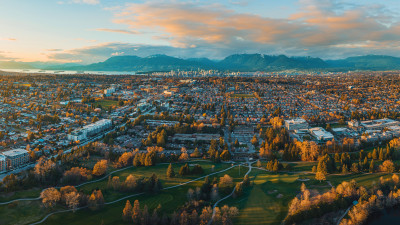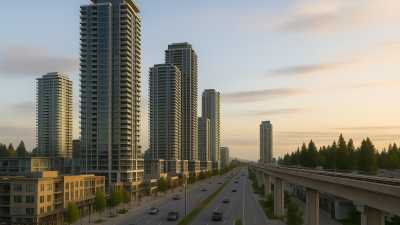Vancouver is experiencing a growth period expected to continue as Canada plans to bring in 1.3 million residents into the country over the next three years, the majority of whom will choose to settle in major markets like the Lower Mainland. As such, good urban design is crucial — supported by the pillars of architecture, infrastructure and sustainability — in order to properly accommodate the anticipated influx of new people.
“Our region is going to have an incredible wave of new immigrants which is going to create an incredible strain in values. It's going to be an unprecedented imbalance between demand and supply and so the government has a real challenge,” said Cameron McNeill, MLA Canada Executive Director and Partner, in regards to the urgency of making sufficient preparations as well as building more housing, and quickly.
“[Fortunately] our urban planning is quite sound. We have density in sensible areas and don't just sprawl, and build our communities around highways and transit. We do have very walkable cities that are only improving — there's an urban planning concept about having nodes where you can work, play and get all your amenities and services within a 10-minute radius of your home.”
Recently, the city invited the public to share their thoughts on the regional growth strategy: Metro 2050. The city already possesses a regional growth strategy titled Metro Vancouver 2040: Shaping Our Future, featuring a series of proposals broken down into five core goals. Some of the highlights are as follows below.
Create a Compact Urban Area
This expands on the point McNeill brought up earlier, aimed at tackling sprawling development that, “consumes the natural landscape, necessitates costly and inefficient urban infrastructure and adds to the global problems of greenhouse gases, peak oil and climate change.”
Instead, creating contained areas with defined boundaries, well served by transit and the road network, and offering both employment and convenient access to shops and services close to home, is desirable.
An example of this can be found in Amacon’s downtown development, Block, located on the corner of Robson and Cambie. Block offers 187 new homes across 30 floors that are within 3 blocks of a variety of amenities, enabling residents to travel short distances for a multitude of necessities and reducing their overall carbon footprint.
Support a Sustainable Economy
To provide for a prosperous future, the second goal recognizes the region as a key gateway location and intends to foster a diverse commercial and industrial base to encourage economic development. Preserving industrial lands is a major component, allowing businesses to expand inside centres and not have to face long travel distances or the associated costs leading to business inefficiencies.
As many tech giants move into the downtown core, like the Amazon headquarters, these new economic relationships will allow Vancouver to provide jobs in the right places, which is a large pillar in this particular goal for the city.
Develop Complete Communities
Complete communities are defined as walkable, mixed use, transit-oriented places where people can reside comfortably no matter their age, earn a living, enjoy social, cultural educational and recreational pursuits, among other things. To achieve this, an adequate supply of diverse housing options is needed, with funding from all levels of government.
McNeill shares that, although our urban planning has been reputably sound, there still lacks an element of planning for affordability as Vancouver and the Lower Mainland continues to grow.
“We understand that Vancouver is special because we have a diverse and healthy urban planning environment. We are strong advocates for the diversity of housing. And we appreciate that communities need seniors housing and compact format homes that provide more affordable options.
"When I reflect on this region that has 17 different municipalities, it is very fractured. There is not a consistent vision. There are some municipalities that are embracing density, and others that are completely allergic to it. And it’s this short-term thinking that is really difficult.
“We need proper infrastructure and a regional plan for our growth of sensible density in logical locations. What concerns me for the future is that we are not going to sort that out. All levels of government have showed us that they’re not thinking long-term and can’t seem move that needle. As a result, we are going to continue having supply difficulties. We are going to continue to have challenges with affordability or have some regions that are under-serviced when it comes to infrastructure,” expressed McNeill.
As development continues to progress throughout the Lower Mainland, it will be crucial that municipalities in Vancouver and beyond work collaboratively in their approach to tackling the concerns for more affordable housing while strategically planning ahead for the future of this region.
Support Sustainable Transportation Choices
The alignment of land use and transportation strategies is necessary to encourage transit, multi-occupancy vehicles, cycling and walking, facilitating efficiency of travel. For example, TransLink’s proposed Frequent Transit Network is a collection of corridors where busses or SkytTrains run every 15 minutes, in both directions, throughout the day and into the evening eliminating the need for users to refer to a schedule.
This expansion of transportation choices is being noticed across the Lower Mainland in conjunction with densification in up-and-coming regions. Having improved transit means new developments can be planned in the surrounding area, allowing for more homes that are closely connected to public transportation. A few regions already doing so include the Surrey Langley SkyTrain extension, The Broadway Subway Project, and a new Port Moody SkyTrain Station proposal.
Among the rest of the Vancouver 2040 plan, there also lies plans for protection of the environment in response to climate change. To learn more, visit www.metrovancouver.org/metro2040.
By MLA Contributor Benjamin Yong



